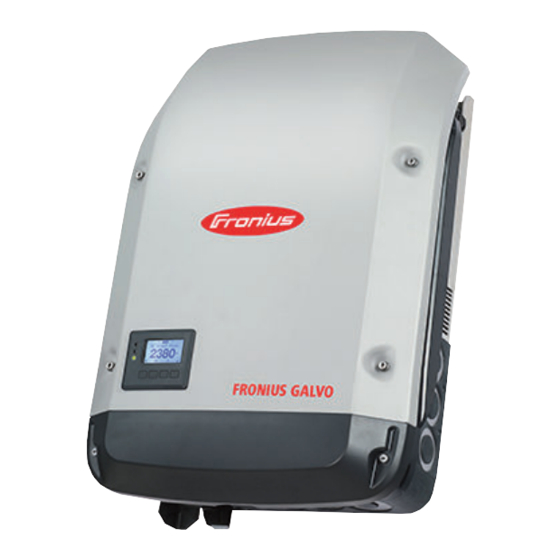
Summarization of Contents
Safety Instructions and Precautions
Safety Instruction Types
Explains different danger levels (DANGER, WARNING, CAUTION, NOTE) and their implications.
General Installation Safety
Outlines essential instructions for safe inverter installation and operation.
Electrical Installation Compliance
Specifies adherence to national and local electrical codes for installations.
Operational and Ground Fault Safety
Warns about dangers from incorrect operation, ground faults, and DC voltage.
Fire Prevention and Cable Safety
Cautions against fire hazards from faulty installations and improper cable connections.
Arc Detection and Liability
States Fronius's non-liability for damages from electric arcs and system checks.
Installation Location and Positioning
Selecting an Installation Location
Criteria for choosing a location, including indoor/outdoor suitability, altitude, and sunlight exposure.
Installation Positions
Details acceptable and unacceptable mounting orientations (vertical, horizontal, sloping).
General Location Selection Criteria
Focuses on selecting a solid, non-flammable surface for installation.
Example: Multiple Inverter Installation
Illustrates proper spacing and connection for multiple inverter setups.
Mounting Bracket Installation
Mounting Bracket Safety Warnings
Covers dangers from residual voltage, ground connection, and terminal soiling.
Selecting Mounting Hardware
Importance of choosing appropriate dowels and screws for secure mounting.
Screw Recommendation
Specifies recommended screw types and dimensions for inverter mounting.
Opening the Inverter
Step-by-step guide on how to open the inverter unit.
Mounting on Brick or Concrete Walls
Instructions for securely attaching the mounting bracket to masonry walls.
Mounting on Timber Walls
Guidance on fitting the mounting bracket to wooden walls.
Preventing Bracket Warping
Emphasizes avoiding warping or deforming the bracket during attachment.
Mounting to Metal Carriers
Procedures for attaching the bracket to metal supports, including weather protection.
Installing on a Mast
Recommends using a standard kit for mounting the inverter on masts.
Knockout Management
Knockout Safety Precautions
Warns about short circuits from loose metal and the need for waterproof conduits.
Knockout Usage and Types
Explains the purpose of different knockout sizes for cable entry.
Removing Knockouts Safely
Detailed instructions and safety measures for knocking out or drilling openings.
AC Connection Safety and Procedures
Connection Safety Warnings
Critical safety advice regarding grid/DC voltage, component sizing, and proper work execution.
Terminal Connection Precautions
Warns about thermal damage from improperly tightened terminals and fire hazards from AC fuses.
Cable and Grounding Notes
Guidelines for aluminum cables, cable looping, and neutral conductor grounding.
Permitted Cable Specifications
Details on approved cable types, cross-sections, and terminal tightening torque.
Preparing Aluminum Cables
Step-by-step process for cleaning and connecting aluminum cables.
Grid Monitoring Requirements
Importance of low resistance for effective grid monitoring.
Ground and Cable Routing
Instructions for ground connection torque and proper AC cable routing to avoid damage.
Solar Module Grounding
Grounding Module in Inverter
Details on the inverter's GFDI fuse for negative grounding and handling ungrounded modules.
Grounding: Negative Pole
Covers NEC2014 for negative pole grounding and ungrounded module configurations.
Grounding: Positive Pole
Covers NEC2011 for positive pole grounding configurations.
DC Connection Safety and Procedures
DC Connection Safety Warnings
Critical safety advice for DC connections, including dangers from voltage, component sizing, and work practices.
Module Grounding Risks
Warns about dangers from incorrect or insufficient solar module grounding.
DC Terminal and Overload Precautions
Cautions against improper terminal connections and overloading the inverter.
DC Grounding and Cable Notes
Rules against connecting ground to DC line, aluminum cable handling, and polarity checks.
Solar Module Frame Grounding
Guidelines for grounding module frames according to manufacturer and national standards.
Data Communication Cable Installation
Laying Data Communication Cables
Comprehensive instructions for laying and connecting data communication cables.
Inverter Mounting and Locking
Clipping Inverter to Wall Bracket
Safety note on swiveling the inverter into the bracket only when the DC switch is off.
Screw Tightness Caution
Warns of damage and fire risk if inverter mounting screws are not properly tightened.
Anti-Theft Device Installation
Optional Anti-Theft Device
Information about the optional anti-theft device and its installation timing.
Installing the Anti-Theft Device
Step-by-step guide for fitting the anti-theft device to the inverter.
Software Updates
Updating Inverter Software via USB
Procedure for updating the inverter's software using a USB stick.
USB Stick Functionality
USB Flash Drive as Data Logger
Using a USB drive to log operational data, viewable in spreadsheet formats.
USB Data File Structure
Details the system, log, and data files created by the data logger function.
CSV File Structure and Limits
Explains the CSV file format, columns, and row limitations for data storage.
Data Storage Capacity and Backup
Information on memory capacity, data logging duration, and backup procedures.
USB Drive Risk Management
Warning about potential data loss with full USB drives and the need for sufficient memory.
Inverter Buffer Memory
Describes the inverter's temporary buffer memory for data logging.
Recommended USB Drives
Guidance on choosing compatible USB thumb drives and supported file systems.
Updating Inverter Software via USB
Procedure for updating the inverter's software using a USB stick.
Safe USB Stick Removal
Safety instructions for removing the USB stick to prevent data loss.
Maintenance and Cleaning
Routine Maintenance Checks
Annual check for screw connections in horizontal/outdoor installations.
Inverter Cleaning Procedure
Instructions for cleaning the inverter using a damp cloth, avoiding harsh chemicals.
Serial Number Identification
Locating the Serial Number
Guidance on finding the inverter's serial number on the rating plate.
Customer Sticker Application
Instructions for applying serial number stickers for customer reference.
















Need help?
Do you have a question about the 2.0-1 and is the answer not in the manual?
Questions and answers